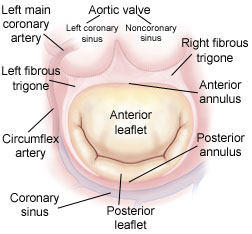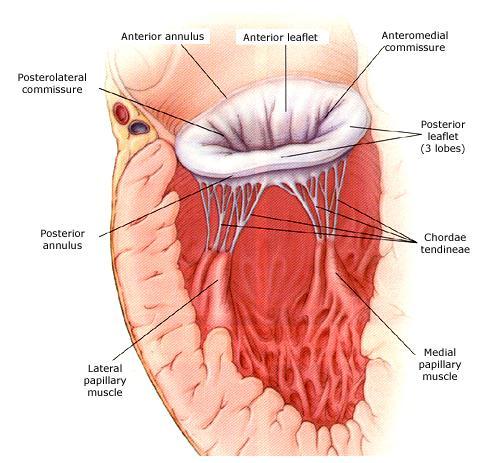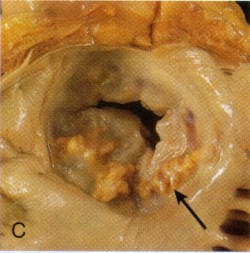“What Is The Mitral Valve Annulus?” Asks Dana
By Adam Pick on September 2, 2008
Some patients want to know EVERYTHING before their operation – the valve anatomy, the surgical process, the recovery details. Other patients want to know absolutely NOTHING about their upcoming surgery. Many say to me, “Honestly Adam, I don’t want to know a thing. The more I know, the more I will worry.”
I can understand both positions. That said, this blog is for those who want to know everything – especially about the anatomy of the mitral valve. Dana just wrote to me, “Adam – Can you help me understand what the mitral valve annulus is? My sister needs mitral valve replacement surgery due to regurgitation and that term – mitral valve annulus – came up in our last discussion.”
No problem Dana. To start, please look at the two figures below. You can see a top- and side-view of the mitral valve. The posterior and anterior annulus is labeled on both diagrams.


As you can see, the mitral valve annulus is a saddle-shaped structure that supports the leaflets of the mitral valve. (Unlike the other three heart valves, the mitral valve has two leaflets that manage the flow of blood through the mitral valve.)
If the mitral valve annulus fails to properly connect with the leaflets or experiences significant calcification (see picture below), the functioning of the heart may be compromised. Both mitral valve regurgitation and stenosis can result.

For example, a mitral valve prolapse occurs when the mitral valve leaflets are displaced more than 2 mm above the mitral valve annulus high points. The condition can be further divided into classic and nonclassic subtypes based on the thickness of the mitral valve leaflets – up to 5 mm is considered nonclassic, while anything beyond 5 mm is considered classic mitral valve prolapse.
I hope this helps explain what the mitral valve annulus is and how it can impact the heart. The good news is that mitral valve surgery can repair or replace many issues with the mitral valve annulus.
Keep on tickin!
Adam
|
R. Mazzacua says on March 31st, 2010 at 4:11 pm |
|
I have been trying to convince a VA doctor about the significance of wide pulse pressure, so far to no avail. My pulse pressure consistently is from 70 to 100. |
 |
|
Adisorn says on July 1st, 2011 at 5:41 am |
|
Wow |
 |











